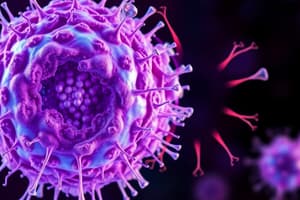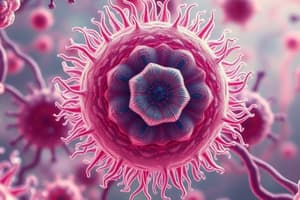Podcast
Questions and Answers
Which statement accurately distinguishes between prokaryotic and eukaryotic cells?
Which statement accurately distinguishes between prokaryotic and eukaryotic cells?
- Prokaryotic cells are larger than eukaryotic cells.
- Prokaryotic cells contain organelles, while eukaryotic cells do not.
- Both prokaryotic and eukaryotic cells lack a cytoplasm.
- Eukaryotic cells have a membrane-bound nucleus, while prokaryotic cells do not. (correct)
What is the main role of the Golgi apparatus in a cell?
What is the main role of the Golgi apparatus in a cell?
- To synthesize ATP through cellular respiration.
- To process and package proteins for export or use. (correct)
- To store genetic material.
- To synthesize lipids and steroids.
Which kingdom is likely characterized by organisms that have cell walls made of chitin?
Which kingdom is likely characterized by organisms that have cell walls made of chitin?
- Animalia
- Fungi (correct)
- Monera
- Plantae
In terms of evolutionary classification, which level represents the broadest category?
In terms of evolutionary classification, which level represents the broadest category?
Which organelle is primarily responsible for intracellular digestion?
Which organelle is primarily responsible for intracellular digestion?
What structure gives plant cells their rigidity and structural support?
What structure gives plant cells their rigidity and structural support?
Which characteristic best describes the Three-Domain system of classification?
Which characteristic best describes the Three-Domain system of classification?
What is the primary function of the endoplasmic reticulum (ER)?
What is the primary function of the endoplasmic reticulum (ER)?
Which of the following statements about the circulatory system is true?
Which of the following statements about the circulatory system is true?
What key event in sexual reproduction distinguishes it from asexual reproduction?
What key event in sexual reproduction distinguishes it from asexual reproduction?
Which of the following best describes natural selection?
Which of the following best describes natural selection?
What role does DNA play in genetics?
What role does DNA play in genetics?
Which of the following levels of ecological organization encompasses all others?
Which of the following levels of ecological organization encompasses all others?
Which type of mutation can lead to a genetic disorder?
Which type of mutation can lead to a genetic disorder?
In the context of biotechnology, what does recombinant DNA technology involve?
In the context of biotechnology, what does recombinant DNA technology involve?
What is the main focus of ecology as a scientific field?
What is the main focus of ecology as a scientific field?
Flashcards
Cell
Cell
The basic unit of life, with a plasma membrane and internal organelles that carry out specific tasks.
Prokaryotic cell
Prokaryotic cell
A type of cell lacking a nucleus and other membrane-bound organelles.
Eukaryotic cell
Eukaryotic cell
A type of cell containing a nucleus and other membrane-bound organelles.
Biological Classification
Biological Classification
Signup and view all the flashcards
Kingdom
Kingdom
Signup and view all the flashcards
Digestive System Function
Digestive System Function
Signup and view all the flashcards
Mitochondria
Mitochondria
Signup and view all the flashcards
Chloroplast
Chloroplast
Signup and view all the flashcards
Asexual Reproduction
Asexual Reproduction
Signup and view all the flashcards
Sexual Reproduction
Sexual Reproduction
Signup and view all the flashcards
Natural Selection
Natural Selection
Signup and view all the flashcards
Adaptation
Adaptation
Signup and view all the flashcards
Mendel's Law of Segregation
Mendel's Law of Segregation
Signup and view all the flashcards
Ecology
Ecology
Signup and view all the flashcards
Evolution
Evolution
Signup and view all the flashcards
Biotechnology
Biotechnology
Signup and view all the flashcards
Study Notes
Cell: The Unit of Life
- Cells are the basic structural and functional units of all living organisms.
- Cells exhibit a remarkable diversity of forms and functions.
- All cells are enclosed by a plasma membrane.
- The internal organization of a cell is complex, with various organelles carrying out specific tasks.
- Prokaryotic cells lack a membrane-bound nucleus and other organelles, while eukaryotic cells possess a nucleus and various membrane-bound organelles.
- The nucleus is the control center of the cell, containing the genetic material (DNA).
- DNA organization varies between prokaryotes and eukaryotes.
- Cytoplasm is the region between the nucleus and the plasma membrane, containing various organelles.
- Ribosomes are the sites of protein synthesis.
- Endoplasmic reticulum (ER) is a network of membranes involved in protein and lipid synthesis and transport.
- Golgi apparatus processes and packages proteins for secretion or use within the cell.
- Lysosomes are involved in intracellular digestion.
- Mitochondria are the "powerhouses" of the cell, responsible for cellular respiration and generating ATP.
- Chloroplasts are specific to plant and algal cells, where photosynthesis takes place.
- Vacuoles are membrane-bound sacs involved in storage and maintaining turgor pressure.
- The cytoskeleton provides support, shape, and facilitates movement.
- Plant cells have a cell wall for structural support.
Biological Classification
- Organisms are classified into various hierarchical categories.
- Broad categories include Kingdom, Phylum, Class, Order, Family, Genus, and Species.
- Classification systems aim to reflect evolutionary relationships.
- Modern classification emphasizes evolutionary relationships.
- Various methods for classifying living organisms have evolved.
- Early classifications were based on observable characteristics.
- Modern classifications utilize molecular data like DNA and RNA sequences.
- The Three-Domain system (Bacteria, Archaea, Eukarya) is a widely accepted classification.
- Key characteristics that differentiate the different kingdoms (e.g., Monera, Protista, Fungi, Plantae, Animalia)
Human Physiology
- This section covers the human body systems and their functions.
- Digestive System: Breakdown of food for absorption of nutrients; Key organs include the mouth, esophagus, stomach, small and large intestines.
- Respiratory System: Gas exchange (oxygen and carbon dioxide); Key organs are the lungs and associated airways.
- Circulatory System: Transportation of materials throughout the body; Blood, heart, blood vessels.
- Excretory System: Removal of metabolic waste; Key organs include kidneys, ureters, bladder, and urethra.
- Nervous System: Coordination and control of body functions; The brain, spinal cord, and nerves.
- Endocrine System: Regulation of body functions through hormones; Endocrine glands.
- Reproductive System: Production of gametes and offspring.
Reproduction
- Asexual reproduction involves a single parent.
- Sexual reproduction involves two parents.
- Types of asexual reproduction include binary fission, budding, fragmentation, spore formation.
- Sexual reproduction often involves meiosis (gamete formation) and fertilization.
- Key events in sexual reproduction include meiosis, gamete formation, and fertilization.
- Reproductive systems in plants and animals differ greatly.
- Reproductive strategies vary across species and are adapted to environment and life cycle.
Genetics
- Mendel's laws of inheritance (segregation and independent assortment).
- Chromosomes and genes function as the carriers of genetic information.
- DNA structure and its role in gene expression.
- Gene and chromosome mutations.
- Genetic disorders (e.g., sickle cell anemia).
- Heredity and its role in human traits.
Evolution
- Evolution is the change in the heritable characteristics of biological populations over successive generations.
- Natural selection is a key driver of evolution.
- Adaptation is the evolutionary adjustment of organisms to their environment, contributing to survival.
- Evidence for evolution is derived from comparative anatomy, embryology, fossil records, and molecular biology.
- Factors contributing to evolution include natural selection, genetic drift, gene flow, mutation.
Ecology
- Ecology studies the relationships between organisms and their environment.
- Levels of organization in ecology include organism, population, community, ecosystem, biome, and biosphere.
- Various ecological interactions exist (predator-prey, competition, symbiosis, etc.).
- Nutrient cycling plays a vital part in ecosystems.
- Biodiversity and its conservation.
- Human impact on the environment.
Biotechnology
- Modern biotechnology uses biological processes, organisms, or systems to develop or make products.
- Applications include genetic engineering, recombinant DNA technology, and cloning.
Human Health and Diseases
- Various factors contribute to human health, including diet, hygiene, and exercise.
- Common diseases, causes and prevention.
- Importance of immunology, vaccination programs and disease control.
Organisms and Processes
- Examples of various organisms and their defining characteristics are considered.
- Study of plant and animal diversity and their adaptation to environments.
- Focus on specific biological processes (e.g., photosynthesis, respiration) and their importance.
Studying That Suits You
Use AI to generate personalized quizzes and flashcards to suit your learning preferences.




